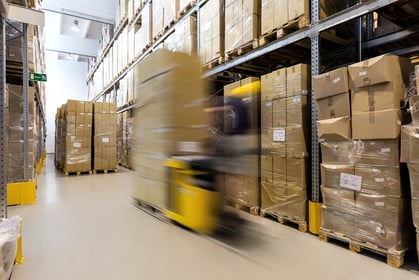The Top 5 Areas of Improvement for Global Logistics Networks
Jesse Kelber - April 23, 2020

The global supply chain has made major strides in the first two decades of the 21st-century. Gone are the days of the right hand not knowing what the left hand is doing. When it comes to optimizing your own organization’s global logistics network, those two hands represent stakeholders in your supply chain, and they often need to know what the other is doing in real-time. Whether it’s your shipping department and sales team, or finance and customer service, multiple stakeholders around the world all need to know where any given shipment is, no matter where on the planet that happens to be. With all the progress already made, there are always going to be areas where further improvement is not only possible but necessary. The following represents our top 5 areas where global logistics networks stand to see major benefits from advancement.
1. Integrating Domestic and International Logistics Workflows
Until quite recently, leading ERP solutions providers struggled to incorporate multi-modal, multi-stage, and multi-carrier journeys into a workflow that any given stakeholder could track in an efficient way. Domestic and international logistics workflows were treated as separate, discrete end-to-end shipments, regardless of their status. This has led to more confusion than necessary when the shipment in question is the same one simply continuing on its way to an international destination.
Now, ERP solutions are coming to market that are able to seamlessly integrate domestic and international journey segments. Real-time information from RFID tags and smart pallets is fed into a centralized analytics engine that makes the data available immediately, no matter where on the planet the shipment is, nor where the stakeholder accessing that data is located. Centralized transportation network management is the goal, and this generation of ERP solutions offers a chance of real progress in that direction.
2. Logistics Process Automation
Business process automation (BPA) is having an impact on how businesses of all sizes and across sectors conduct their internal processes for some time now. Software solutions exist that can help any back-office cut costs and speed up processes for impressive ROI gains. The emerging technology that has powered BPA is expanding its reach and is ready to tackle your global logistics processes. There are estimated to be as many as 25-30 hand-offs along an average global supply chain. This seems to present a major hurdle to automation, as in the past it’s been difficult to synchronize that many divergent systems. With the advent of robotic process automation (RPA) and the release of full-suite ERP systems that have a more global focus, these difficulties are melting away.
RPA is a solution that consists of software ‘bots’ that can be trained to conduct any set of inputs that a human can do, all by using the same user interfaces. This means that no matter how outdated a partner’s systems are, the integration of your ERP with their inventory management tool can be automated. Add to that the fact that ERPs are coming to market that assume an international supply chain, rather than the former industry-standard assumption that companies would only operate locally, and you can see how these technologies can help decrease costs associated with tracking and managing shipments across borders.
3. End-To-End Visibility
One of the goals of process automation is to collate data from those divergent systems into a single source of truth. This is a single data store where any stakeholder can look to find whatever information they might need—about a shipment, a process, or even a partner in the supply chain. With the strategic use of the industrial internet of things (IIoT), that information can be funneled into this data store nearly in real-time. Sensors in production facilities, RFID trackers on pallets, and advanced analytics parsing the incoming data stream are all real possibilities that can assist in moving your logistics network into the 21st-century.
At a basic level, true global logistics network visibility means that any particular stakeholder should be able to answer the questions, “where is it, and when will it get here?” at any given point in time, for any given product or shipment. And the answers to those questions lie in the data fed into your analytics by those IIoT devices and other Industry 4.0 technologies. When a key stakeholder can open a unified dashboard and locate that shipment on a truck crossing Germany, all from their desk in Los Angeles, you’ll have end-to-end logistics network visibility.
4. Supply Chain Security and International Regulatory Compliance
As the supply chain becomes increasingly international, threats to the integrity of the materials and products being shipped increases as well. This highlights the important role safety rules and regulations need to play in ensuring the safety of products and workforces alike. Already, in many jurisdictions, if carriers aren’t in compliance they’re subject to harsh penalties that can include delays in port or even container confiscation.
Tracking solutions like RFID chips are taking the lead in setting logistics carriers up for better oversight of their international shipments. These devices allow a central office to see, at a glance, the status of every shipment in their network. This way, should a problem with compliance arise, the home office can be alerted and can monitor the proceedings. The biggest stumbling block here seems to be a lack of understanding of the value in adhering to voluntary rules now, in favor of easing future transitions to legally binding regulations.
5. Planning and Execution Platform Integration
Data silos are the bane of logistics managers everywhere. Nowhere is this more evident than systems where planning and execution are done on completely different platforms with no level of integration or communication between them. The ability to create a single source of truth for all transportation logistics information for the end-to-end supply chain is still a dream, albeit one that we’re seeing great progress toward.
The new generation of ERP solutions mentioned above is one important piece of the puzzle that’s coming together in support of this idealized integration. Planners are able to input their logistics requirements, and immediately thereafter the execution team across the globe can see those requirements and begin working to make it a reality.
If you want to learn more get your Guide to Logistics 4.0
In this Guide you will learn:
-
Why a strategic process in transportation planning is a top priority for digitalization
-
What megatrends will increase supply chain volatility
-
How to manage it
LATEST POSTS
- Understand Circular Economy in The Manufacturing Industry
- How Can Industry 4.0 IT Integration Be Achieved Smoothly?
- The Significance of Order Sequencing in Discrete Manufacturing
- How to improve your Supply Chain Management: The Power of Control Towers
- Optimizing Human Resource Scheduling in Manufacturing: A Technological Approach



